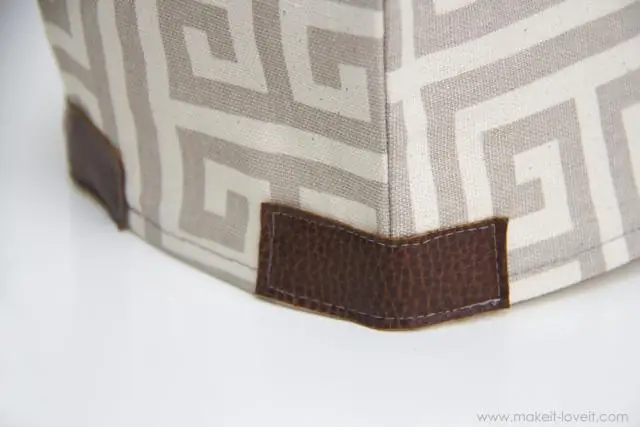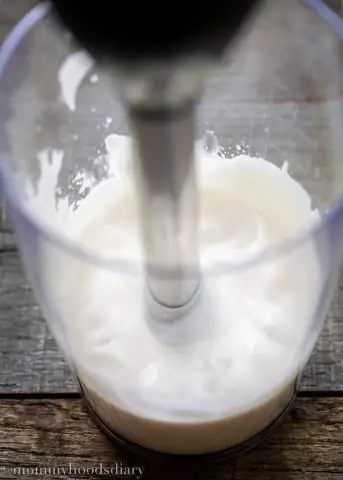
Table of contents:
- Author Bailey Albertson [email protected].
- Public 2023-12-17 12:53.
- Last modified 2025-01-23 12:41.
How to iron a jacket quickly and efficiently - advice from experienced housewives

The jacket has become so firmly established in our life that we often do not realize its meaning. We see a fit, elegant man with a clear shoulder line, waist and no belly. He behaves freely and confidently, seems to be a reliable partner in business and in family life. But in many ways this effect is achieved thanks to a well-fitting jacket, but we pay attention to the man, and not to what he is wearing. Famous designer Giorgio Armani once said about this: "When you have a good jacket, everything else will follow." However, not everyone knows how to iron this irreplaceable item of men's wardrobe correctly.
Content
- 1 In what cases it is necessary to iron a jacket
-
2 Preparatory process
- 2.1 Cleaning
- 2.2 Definition of fabric and, accordingly, ironing strategy: woolen, corduroy, linen and other options
- 2.3 Correct sequence of actions
- 2.4 Video: How to iron the sleeves of a jacket
- 2.5 Video: Smoothing a men's jacket
- 2.6 Video: How to iron in 3 minutes at home
When do you need to iron a jacket

The jacket should always look neat
The answer is obvious - in cases where it is wrinkled. But, do you need to use a hot iron, trowel, sprayer and other arsenal of ironing accessories every time? No, sometimes you can do without them.
- One way to get an unwrinkled jacket is to properly dry it after washing. Hang the jacket, without twisting it, on a hanger, smooth it out with your hands, then let it drain and dry in this position. Your item will dry out and will not wrinkle, therefore, you will not need to iron it at all.
-
A steam generator can be an excellent alternative to the iron. With its help, you can straighten all folds and creases on natural and mixed fabrics. The simple function of vertical steaming on the iron will most likely not be enough, at least for jackets made of thick fabrics, but with a lighter, delicate fabric, the iron will most likely cope with success.

Steam generator An alternative to an iron - a steam generator
- After folded storage, unfold the jacket and hang it on a hanger, neatly straightening the lapels, sleeves and pockets. The jacket can simply sag and flatten under its own weight. If it doesn't, move the coat hanger to the bathroom with a tub filled with hot water and close the door. The jacket is moistened and steamed, from which non-fatal wrinkles should be smoothed out.
- By the way, the jacket may not be ironed at all if it is folded correctly beforehand. How to do this can be seen in the following video:
But there are times when only an iron can be better than an iron.
Preparatory process
Cleaning
The first condition under which you can start ironing anything, and especially a jacket, is its cleanliness. It is not necessary to start a wash every time on this occasion, but it is possible and necessary to clean it with a clothing brush, inspect it for stains and shiny areas. If a disorder is found, remove it, and only then grab the iron, otherwise the dirt will “weld”, penetrate deep into the fabric, and it will be much more difficult to get rid of it.
- Hair and dust can be brushed off with a damp palm, brush or adhesive roller.
- A dirty collar can be wiped with a cut of raw potatoes, then wiped with a damp cloth, and finally with a dry cloth.
- Glossy areas are a common problem, but you can deal with it too. We take salt and ammonia in a ratio of 1:15 (1 part of salt to 15 parts of ammonia), moisten a cotton swab and wipe the problem area, after which we ventilate the jacket, preferably in the fresh air. There is another popular method suitable for dark fabrics - to wipe the shiny place with a cotton swab dipped in strong tea leaves.
- More serious stains require individual attention and possibly dry cleaning.
Definition of fabric and, accordingly, ironing strategy: woolen, corduroy, linen and other options
Find the manufacturer's care labels for your product. If the fabric is to be ironed, the label should be marked with the optimum temperature for this. The composition of the fabric from which your jacket is sewn will also be indicated, and based on this, prepare it for ironing properly.
-
Wool and wool blend blazer

Wool blazer Wool and semi-wool jacket requires thoughtful approach
The woolen jacket is always ironed through the fabric. For this, you can use a damp piece of clean, undyed cotton or linen cloth. In Soviet families, traditionally, for this, they adapted gauze folded in several layers, and were satisfied with the result. Due to the fact that wool easily shrinks and stretches, during ironing try not to crawl with the iron, especially at the seams, but gently apply it to a damp cloth. You can leave the jacket itself slightly damp, then the cloth is no longer wet. Everything should be dry at the end of ironing. The heating temperature of the iron should not exceed 165 °.
-
Corduroy

Corduroy jacket Ironing methods for corduroy products
A corduroy jacket should be ironed very carefully and even gently. Firstly, it does not need to be completely dried, but left slightly damp. Secondly, corduroy cannot be ironed on a hard board with a hot iron and from the front side. This is done exclusively from the inside out, in the direction of the pile, on a board with a thick layer of soft upholstery, or on a towel. And best of all on weight: the iron is fixed up with the sole, heats up, charges with water and turns on the steam function. Then, with a velvet cloth, the front side is gently - lightly rubbed over the hovering surface of the iron. With this ironing, corduroy blooms like poppies: the pile rises, the folds are smoothed out, and your jacket looks like new.
-
Velvet and plush jackets

Velvet blazer Ironing a velvet jacket
Velvet and plush jackets are all the rage these days. The first option for ironing is from the inside out and by weight. First, we fix one edge of the jacket on the table or ironer, pull the other edge with our left hand and with light, quick movements we carry it with the heated sole of the iron (through gauze). In this case, the fabric should be slightly damp. Jams can be removed very simply: hold the jacket, nap down, over steam (a pot of boiling water). Another way to iron velvet items is with a feather pillow. The key word is "feather". The pillow is covered with a clean, unpainted linen (ideally) or cotton cloth, the jacket is placed on top, inside out, with a damp cloth or gauze on top. Ironing is carried out by light touches to the cloth. Then we leave the jacket on a hanger so that it is well ventilated and dry. After such ironing, the velvet becomes like new. The feathers inside the pillow warm up and give off heat to the fabric, which makes the pile straighten out on it. As they say in the army, there is one more option, even two. Place the velvet jacket, nap down, on a wet, but well-wrung out terry towel and iron from the wrong side. And the second option is to fold it in half, pile to pile, and press it from the inside out through a damp cloth.
-
Linen or cotton jacket

Linen blazer Linen products are usually left slightly wrinkled
In the appearance of linen and cotton products, as a rule, slight bruising is allowed. But you still have to stroke him, because this stage still needs to be reached. At the same time, the jacket should be damp, but not wet, if it dries up completely during ironing, you will have to moisten a cloth or gauze on which the iron will pass. If the jacket is unlined, you can iron it at a high temperature, about 200 - 230º from the wrong side through a cloth. If there is a lining, you will have to set a temperature suitable for the fabric from which it is sewn, otherwise the high temperature will deform the lining and disfigure your jacket. Time, of course, will have to be spent more, but beauty requires sacrifice, as you know.
-
Natural silk jacket

Silk blazer A silk jacket should be ironed with great care
It is better not to iron a silk jacket at all, as a rule, the manufacturer says so on the label. If you still feel an urgent need to get rid of any folds and bruises, approach this process with feeling, plainly, arrangement. First, take a look at the values on the iron, some models have a special ironing mode "silk". If you are deprived of such happiness, do not be sad where ours did not disappear. Expose the iron at 150º or between "wool" and "nylon" and lay out the damp jacket on the ironing pad, covered in advance with a clean, unpainted linen or cotton cloth. If your jacket has time to dry, sprinkle it with boiled, settled water from a spray bottle and hold it in a plastic bag, and start ironing only after the fabric is evenly moistened. We pass the iron from the seamy side through gauze or a cloth. There are two more options - to buy an attachment for the sole of an iron "for silk" or to steam a jacket without using an iron. First, hang it on a hanger, cover with a layer of gauze, and then work with a steamer at a distance of at least 6-7 cm and in warm, not hot steam mode. In general, you like to ride in a smooth silk jacket, love and carry a sled with special devices for ironing it.love and carry a sleigh with special devices for ironing it.love and carry a sleigh with special devices for ironing it.
-
Polyester blazer

Polyester blazer The synthetic fabric is ironed at a low temperature
The polyester jacket is almost wrinkle-free, so you don't need to iron it often. But you can hardly do without it, so here are some recommendations. Firstly, unlike natural fabrics, polyester is non-hygroscopic (does not absorb steam), and therefore steaming will not bring any results. The choice of the optimal temperature will be made easier by the same label. If in doubt, try on a piece of fabric that usually sticks out of the seam on the back of the jacket.
-
Leather jacket

Leather jacket It is better not to iron leather products with an iron.
As a rule, leather goods are not ironed with an iron. You can simply hang it on a hanger so that it straightens under its own weight. The leather jacket is quite heavy, so in the end it will definitely straighten, it is a matter of time, from 1-2 days to a week. If you don't have that much time, try steaming your jacket over a hot tub or using a steam generator. There is one more sure way of smoothing a leather product - wipe the wrinkles with a cotton swab dipped in vaseline or walnut oil.
Correct sequence of actions
-
Install an ironing board. If not, you can use a double-folded towel spread out on a flat, heat-resistant surface.

Ironing board We start ironing by installing the trowel
-
Fill the water tank in your iron if you plan on using steam. Also prepare a white linen or cotton cloth or gauze, a bowl of clean, settled water, or a spray bottle to moisten it.

Iron with steamer Set the iron to steam mode
- Set the iron to the desired temperature, wait until it heats up, and only then start ironing, because water will spill from a poorly heated iron and leave unplanned stains on the fabric.
- It is more convenient to start ironing from the pockets. We turn them inside out, iron them through a damp cloth, fill them in place.
-
The next step is to iron the sleeves. The point is that in the end there are no folds and arrows. This can be achieved in the only way - by filling it with something on which you can iron. This can be a special attachment to the ironing board in the form of a mini-ironer or a terry towel wrapped around a rolling pin.

Ironing the sleeves of the jacket It is more convenient to iron the sleeves of the jacket with the help of additional accessories
- Let's move on to the hangers. You can put special pads or try to spread them on the same devices as the sleeves. We iron carefully, moving the iron from place to place, and not sliding it over the fabric, and especially along the seams.
-
Now we start ironing the hem, backrest and shelves. Carefully lay out the jacket with the right side up (if the fabric allows), smooth out the folds with your hand, then cover with a damp cloth or gauze and begin to iron.

Ironing the back of the jacket You need to iron the jacket by carefully rearranging the iron from place to place, and not sliding it over the fabric
- The last thing we do is the collar and lapels. We also iron these parts from the front side (if possible) through a damp cloth. First we turn off the lapels, iron them, then fold them as they look in finished form, and iron them again (do not forget to put a damp cloth every time). With a strong jam, pull the fabric with your left hand, and gently iron it with your right hand, or rather, put the iron on the problem area several times.
-
At the end of ironing, hang the jacket on a hanger and let it dry and cool in this position. Only then can the jacket be put on.

Hang a jacket on a hanger At the end of ironing, hang the jacket on a hanger
Video: How to iron the sleeves of a jacket
Video: Smoothing a men's jacket
We have already mentioned steaming as an alternative to ironing. There are several other ways to get by without your good old metal friend.
- If you still need to iron, but there is no iron, use a metal mug. The thing is not the most popular in our time, but in many homes it can still be found. Pour boiling water inside and iron with a mug just as you would with an iron.
- Lay the jacket gently on something solid, smooth out any wrinkles and wrinkles, and press down with something heavy, such as yourself. You can sit or lie down on a thing that needs ironing. Travelers and students have long used this method of straightening wrinkled things. We laid out what needed to be ironed under the mattress, slept through the night and got a neatly smoothed jacket or trousers the next morning.
Video: How to iron in 3 minutes at home
Finally, an anecdote to the topic. The husband says to his wife: - I asked you to iron my jacket! - But I stroked! - Not true! One hundred dollars as lay in the inner pocket, and still lie!
Recommended:
How To Iron A Leather Jacket At Home, Can It Be Ironed Or Steamed, How To Iron A Leatherette Product + Video And Photos

How to smooth out a wrinkled leather jacket or leatherette item? New and proven methods of ironing at home will help solve this problem
How To Iron Trousers With And Without Arrows, The Nuances Of Ironing + Video And Photos

To look like a brand new clothes, you need to be able to iron things correctly. Especially if it's pants
How To Make Mayonnaise At Home: Recipes With Eggs, Milk And Without, In 5 Minutes And Others, Video

Homemade mayonnaise recipes. Classic mayonnaise, no eggs, milk-based, lean and vegetarian. Ingredients, cooking secrets
Seedlings Of Eggplant At Home: Planting According To The Lunar Calendar 2019, Features Of Growing In Different Ways, Rules For Leaving With Video

How does growing eggplant seedlings differ from growing any other, why you need to do it and how to avoid mistakes when planting at home
How To Descale The Iron Inside At Home In Various Ways + Video And Photo

How to descale your iron: advice from manufacturers, features of cleaning different parts of the appliance, methods of descaling at home. Instructions. Video
